Tamron SP AF 200-500mm F/5-6.3 Di LD (IF)
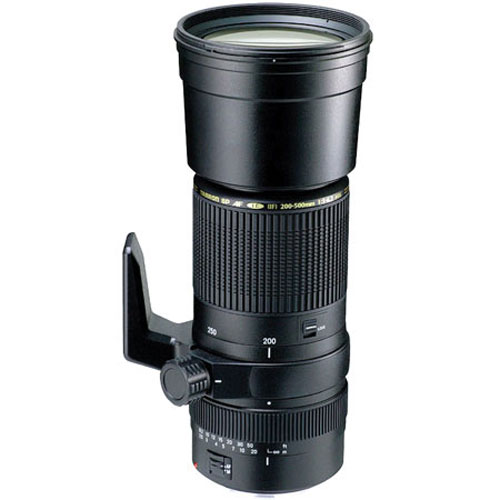 |
This super-telephoto zoom lens from Tamron costs around £865 and has an internal focus design and is relatively lightweight for its focal range. Photographers looking for something more telephoto than the standard 70-300mm range will look to a lens like this for capturing subjects such as birds and wildlife.
Sigma currently offer two lenses of a similar range. Their 150-500mm lens costs £695 and has optical stabilisation and a silent, hyper sonic focusing motor. They also offer a similar 120-400mm lens, which apart from being 100mm shorter at the long end is £100 cheaper than the 150-500mm. Sigma also offer a 500mm f/4.5 prime lens for those absolutely serious about the 500mm focal length. As a result it comes with a very serious price tag of around £3850.
Tokina's only super-telephoto lens is their 80-400mm f/4.5-5.6, which is currently the smallest and lightest 400mm zoom available. This lens costs around £570.
None of the main camera manufacturers currently offer a zoom lens covering up to 500mm. Canon's 100-400mm f/4-5.6L IS USM lens has an Image Stabiliser and silent focusing motor, but costs around £1168. Canon's 500mm f/4L IS USM will currently set you back around £5740.
Nikon's super-telephoto zoom lenses both stop at 400mm. The older and cheaper of the two is the 80-400mm VR, which has Vibration Reduction but costs around £1168. Their 200-400mm f/4 maintains the bright f/4 aperture throughout the zoom range, so could be used with a 1.4x teleconvertor to effectively give you a 280-560mm f/5.6 lens with VR, but the lens alone will set you back £4660. Nikon's 500mm f/4 prime telephoto lens costs £5740.
Sony offer a 70-400mm lens with a silent focusing motor, which is available for around £1300. Their only 500mm prime is a catadioptric one with a fixed aperture of f/8 that can be had for around £535.
Tamron SP AF 200-500mm f/5-6.3 Di LD (IF): Handling and features
Weighing in at only 1237g, this lens is surprisingly easy to hand hold for its size, being 227mm long. The light weight certainly helps when hand holding the lens over an extended period of time. I find the lens balances well with my Nikon D700 with or without the MB-D10 battery grip attached.
As there is no stabilisation on this lens, and the maximum aperture is quite modest at f/5-6.3, some kind of support such as a monopod of beanbag may be required when the light levels aren't ideal. A lightweight, yet sturdy removable magnesium alloy tripod foot is supplied for attaching such a support. The zoom ring is located just in front of the tripod mount and can be adjusted with the lightest of touches. A little more resistance in the zoom mechanism may have been welcome, as I did notice the zoom creeping forward if the camera was left tilted downwards unattended, such as when using a tripod. A zoom lock switch is provided to lock the lens at the shortest focal length during transport.
As the lens is an internal focus design, the lens does not extend during focus, and the front filter ring does not rotate. This is great for users of polarising filters as a rotating front element would change the polarisation effect as you focused. To further enhance the use of polarisers, a Filter Effect Control ring is supplied screwed into the 86mm front filter thread. This allows filters to be rotated easily, even when the huge supplied hood is attached.
The supplied hood is massive, so should do an excellent job of shielding the front element from extraneous light. Although this lens doesn't have a silent focus motor, the motor used isn't overly noisy, and focuses fast enough for most subjects.
Tamron SP AF 200-500mm f/5-6.3 Di LD (IF): Performance
For this review, the lens was tested on a 12Mp Nikon D700 using Imatest.
At 200mm this lens produces images with good resolution in the centre at every aperture setting. The quality towards the edges of the frame improves as the lens is stopped down, with the best quality being achieved at f/16.
By 300mm, this lens maintains it's good resolution in the centre of the image at all apertures. Peak performance is obtained at f/11 where the resolution in the centre is very good, and not too far behind towards the edges of the frame.
The quality is maintained at 500mm, with there being no clear peak in performance at any aperture although the resolution recorded at f/6.3 and f/8 is ever so slightly higher than when the lens is stopped down.
| Resolution at 200mm |
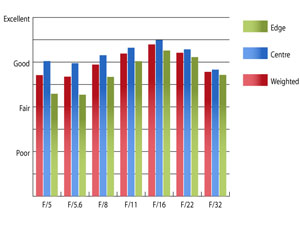 |
| Resolution at 300mm |
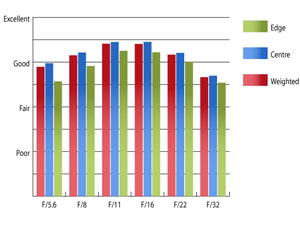 |
| Resolution at 500mm |
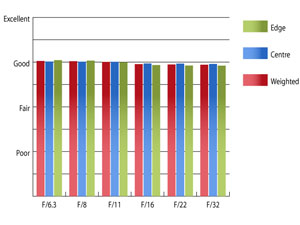 |
Telephoto lenses have traditionally been the ones to have the biggest issues with colour aberrations. This lens doesn't perform too badly, with chromatic aberration being kept well below acceptable levels at 200mm and 500mm. At 300mm however, the level of fringing rises a little, and increases as the lens is stopped down. Wide open it is more than acceptable, but stopped down to f/11 or smaller, it may start to become noticeable.
| Chromatic Aberrations at 200mm |
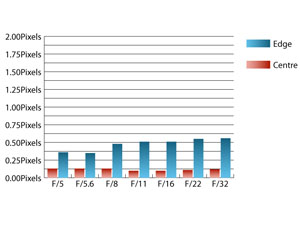 |
| Chromatic Aberrations at 300mm |
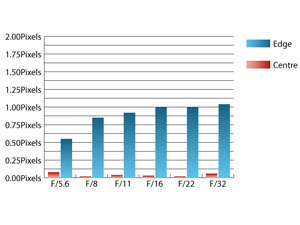 |
| Chromatic Aberrations at 500mm |
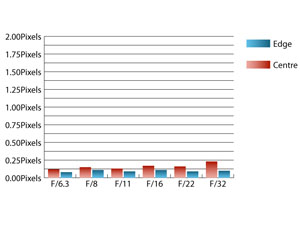 |
At 200mm, light falloff towards the corners is well controlled with the corners only being 0.8 stops darker than the image centre. At 500mm, the effect may become more noticeable, with the corners being 1.7 stops darker than the centre of the image. Stopping down to f/11 will provide even illumination.
Imatest recorded 1.13% pincushion distortion at 200mm, which is already quite strong and may become noticeable in critical applications. The level of distortion stays roughly the same throughout the zoom range, actually decreasing slightly at 500mm to 1.03% pincushion.
| Click the thumbnail to open the larger image. |
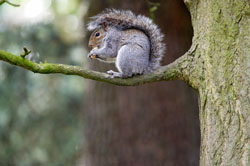 |  |
This lens' control of flare and ghosting is very good indeed. Strong point sources of light in the frame didn't cause any noticeable flare, or loss of contrast. The huge hood, which is half the length of the lens itself, does a sterling job of protecting the front element from extraneous light.
Tamron SP AF 200-500mm f/5-6.3 Di LD (IF): Verdict
Although this lens may be a little more expensive than some of the competition and it lack some features such as image stabilisation, the optical quality of this lens is good for the price.
Tamron SP AF 200-500mm f/5-6.3 Di LD (IF): Pros
 Good resolution throughout the zoom range
Good resolution throughout the zoom range Low CA at 200mm and 500mm
Low CA at 200mm and 500mm Relatively light weight
Relatively light weight Filter effect control system useful when using a polariser
Filter effect control system useful when using a polariserTamron SP AF 200-500mm f/5-6.3 Di LD (IF): Cons
 Higher CA levels at 300mm
Higher CA levels at 300mm Zoom creeps when lens is pointed downwards
Zoom creeps when lens is pointed downwards 86mm filter size
86mm filter size| FEATURES |  |
| HANDLING |  |
| PERFORMANCE |  |
| VALUE FOR MONEY |  |
| OVERALL |  |
Tamron SP AF 200-500mm f/5-6.3 Di LD (IF): Lens specification
| Price: | £865 |
| Contact: | http://www.tamron.co.uk |
| Filter size: | 86mm |
| Format: | Full-frame |
| Construction: | 13 elements in 10 groups |
| Angle-of-view: | 12°-5° |
| 35mm equivalent focal length (on APS-C body): | 300-750mm |
| Internal focusing: | Yes |
| Image stabilisation: | No |
| Minimum focus | 250cm |
| Maximum aperture: | f/5-6.3 |
| Minimum aperture: | f/32 |
| Weight: | 1237g |
| Size (lxw): | 227mm x 93.5mm |
| In the box: | Lens Hood, Padded Case |
The Tamron SP AF 200-500mm f/5-6.3 Di LD (IF) costs £864.99 and is available from Warehouse Express here:
Tamron SP AF 200-500mm f/5-6.3 Di LD (IF) - Canon Fit
Tamron SP AF 200-500mm f/5-6.3 Di LD (IF) - Nikon Fit
Tamron SP AF 200-500mm f/5-6.3 Di LD (IF) - Sony/Minolta Fit
Add your message
Login required
Please login here or if you've not registered, you can register here. Registering is safe, quick and free.
Please login here or if you've not registered, you can register here. Registering is safe, quick and free.
photodo Stats
1102 lenses
428 MTF tests
74 in-depth photodo reviews
100+ users join each day
Help the lens community by reviewing or rating a lens today via our lens search
428 MTF tests
74 in-depth photodo reviews
100+ users join each day
Help the lens community by reviewing or rating a lens today via our lens search
Latest Lens Reviews
- Chinon 28mm f/2.8 Vintage Lens Review
- Canon EF 70-200mm f/4L IS II USM Lens Review
- Samyang AF 85mm f/1.4 EF Review
- Sigma 70mm f/2.8 DG Macro Art Review
- Samyang AF 24mm f/2.8 FE Review
- Meike 50mm f/1.7 Review
- Tamron 70-210mm f/4 Di VC USD Review
- Lensbaby Burnside 35mm f/2.8 Review
- Asahi Super Takumar 50mm f/1.4 Review
- Asahi Super-Multi-Coated Takumar 135mm f/3.5 Review
